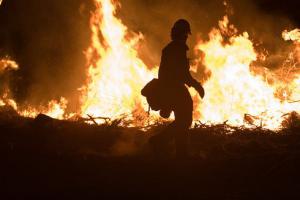WildfiresHuman activity a major factor driving wildfires
A new study that examines California wildfires found that human activity — such as tossing a lit cigarette along a highway — explains as much about the fires’ frequency and locations as climate influences. The researchers systematically looked at human behaviors and climate change together, a type of review that rarely is attempted on an area of land the size of California.

Firefighter silhouetted against the flames of a back burn // Source: commons.wikimedia.org
A new study that examines California wildfires found that human activity — such as tossing a lit cigarette along a highway — explains as much about the fires’ frequency and locations as climate influences.
The researchers, including the study’s author, GW Assistant Professor of Geography Michael Mann, systematically looked at human behaviors and climate change together, a type of review that rarely is attempted on an area of land the size of California.
GWU notes that the newest model proportionately accounts for climate change and human behavioral threats and allows experts to more accurately predict how much land is at risk of burning in California through 2050 — about seven million acres over the next twenty-five years.
Between 1999 and 2011, California reported an average of $160 million in damages annually related to wildfires. That devastation by California wildfires could reach $500 million annually by 2050, Mann said.
“Individuals don’t have much control over how climate change will affect wildfires in the future,” Mann said. “However, we do have the ability to influence the other half of the equation, those variables that control our impact on the landscape.
“We can reduce our risks by disincentivizing housing development in fire-prone areas, better managing public land and rethinking the effectiveness of our current firefighting approach.”
The study was published in PLOS ONE.
The findings suggest many models of wildfire predictions do not accurately account for human factors and could be misleading when identifying the main causes or drivers of wildfires.
Climate change affects the severity of the fire season and the amount and type of vegetation on the land, which are major variables in predicting wildfires.
However, humans contribute another set of factors that influence wildfires, including where structures are built and the frequency and location of ignitions from a variety of sources — everything from cigarettes on the highway to electrical poles that get blown down in Santa Ana winds.
As a result of the near-saturation of the landscape, humans currently are responsible for igniting more than 90 percent of the wildfires in California.
The researchers found that omitting the human influence on California wildfires overstates the influence of climate change on the fires. The authors recommend considering climate change and human variables at the same time for future models.
“There is widespread agreement about the importance of climate on wildfire at relatively broad scales. At more local scales, however, you can get the story quite wrong if you don’t include human development patterns,” said Max Moritz, a co-author of the study whose lab is at the University of California, Berkeley. “This is an important finding about how we model climate change effects, and it also confirms that getting a handle on where and how we build our communities is essential to limiting future losses.”
The fires destroyed nearly 13,000 homes and other structures in so-called state responsibility areas—fire jurisdictions maintained by California, according to Mann. During this same period, California and the U.S. Forest Service spent more than $5 billion on wildfire suppression.
In a model from 2014 that examined California wildfires’ destruction over the past 60 years, Dr. Mann estimated that fire damage would more than triple by 2050, increasing to nearly $500 million annually. “This information is critical to policymakers, planners and fire managers to determine wildfire risks,” he said.
— Read more in Michael L. Mann et al., “Incorporating Anthropogenic Influences into Fire Probability Models: Effects of Human Activity and Climate Change on Fire Activity in California,” PLOS One (28 April 2016) (doi: org/10.1371/journal.pone.0153589)
